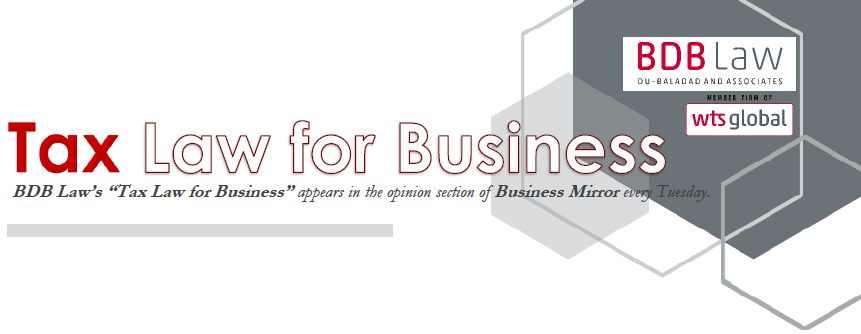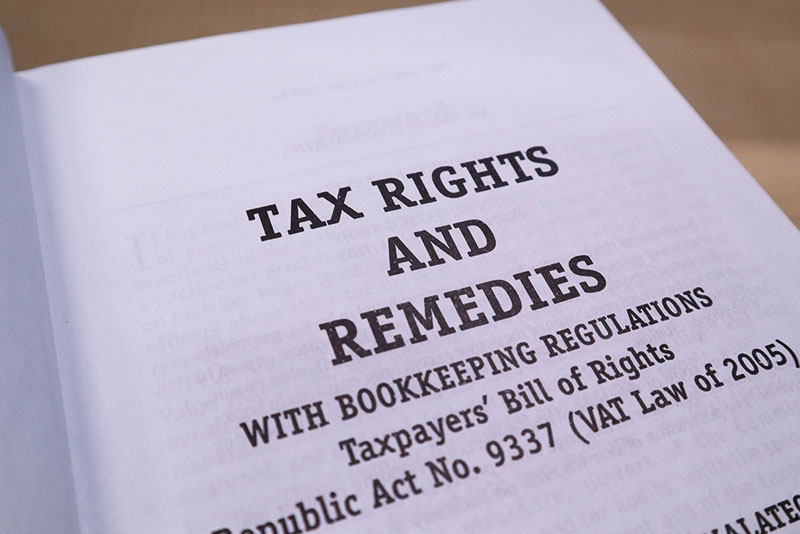
Exhaustion of administrative remedies in claims
for refund of erroneously paid taxes
By Atty Rodel C. Unciano
"Given the circumstances, and in the meantime that there is no definitive rule on this issue, the prudent approach therefore is to file the administrative claim at the earliest possible opportunity within the two-year prescriptive period, and if the claim remains unacted, to elevate the same to the Court at the latest possible opportunity, also within the two-year prescriptive period."
Happy new year!
Under the Tax Code, the procedures for claiming for refund of erroneously paid taxes are laid down under Sections 204 and 229. Section 204 applies to administrative claims for refund with the Bureau of Internal Revenue (BIR), while Section 229 applies to judicial claims for refund.
Section 204 provides that no credit or refund of taxes or penalties shall be allowed unless the taxpayer files in writing with the Commissioner a claim for credit or refund within two (2) years after the payment of the tax. And pursuant to Section 229, no suit or proceeding shall be maintained in any court for the recovery of any national internal revenue tax alleged to have been erroneously or illegally collected until a claim for refund or credit has been duly filed with the Commissioner.
 Following the rules, both the administrative and judicial claims for refund must be filed within the two-year prescriptive period.
Following the rules, both the administrative and judicial claims for refund must be filed within the two-year prescriptive period.
However, a taxpayer-claimant must first file an administrative claim for refund with the BIR before filing a judicial claim for refund with the Court. It has been settled that this does not mean that the taxpayer must await the final resolution of its administrative claim for refund before seeking judicial recourse, since doing so would be tantamount to the taxpayer's forfeiture of its right to seek judicial recourse should the two-year prescriptive period expire without the appropriate judicial claim being filed.
While it is settled that both the administrative and judicial claims should be filed within the two-year prescriptive period and that the administrative claim must be filed prior to filing of the judicial claim, there is so far no definitive rule on the required amount of time or number of days that the taxpayer has to wait from the filing of its administrative claim prior to filing of the judicial claim. It is clear that the taxpayer need not wait for the resolution of its administrative claim but if the claim remains unacted by the BIR, how long a time should the taxpayer wait prior to filing of its judicial claim?
In one case, the taxpayer filed an administrative claim for refund of excess and unutilized creditable withholding taxes on January 15, 2019. It filed its judicial claim before the Court of Tax Appeals (CTA) on the following day. The Court ruled that the filing of judicial claim for refund a day after the filing of administrative claim for refund does not comply with the requirement of exhaustion of administrative remedies. A period of one day is insufficient for the BIR to resolve the administrative claim for refund considering that the claim has voluminous documents.
In another case, the taxpayer filed a claim for refund with the BIR and the CTA on the same day. The Court said that the filing of the administrative claim with the BIR and judicial claim with the CTA on the same day does not constitute “prior filing” set forth under Section 229 of the Tax Code. The filing of both the administrative claim and judicial claim for refund on the same day is akin to the concurrent filing of the subject claims.
Here, the taxpayer argued that it actually filed its administrative claim for refund prior to filing of its judicial claim for refund. But the CTA ruled that the prior-filing requirement has not been complied as the filings were done on the same day.
Given the circumstances, and in the meantime that there is no definitive rule on this issue, the prudent approach therefore is to file the administrative claim at the earliest possible opportunity within the two-year prescriptive period, and if the claim remains unacted, to elevate the same to the Court at the latest possible opportunity, also within the two-year prescriptive period.
Of course, it is to the advantage of the taxpayer-claimant to wait for the BIR’s resolution on the administrative claim but if the claim remains unacted upon by the BIR and the two-year prescriptive period is about to expire, it’s time to prepare for legal battle, otherwise right to judicial appeal is gone forever.
The author is a partner of Du-Baladad and Associates Law Offices (BDB Law), a member-firm of WTS Global.
The article is for general information only and is not intended, nor should be construed as a substitute for tax, legal or financial advice son any specific matter. Applicability of this article to any actual or particular tax or legal issue should be supported therefore by a professional study or advice. If you have any comments or questions concerning the article, you may e-mail the author at This email address is being protected from spambots. You need JavaScript enabled to view it. or call 8403-2001 local 140.




